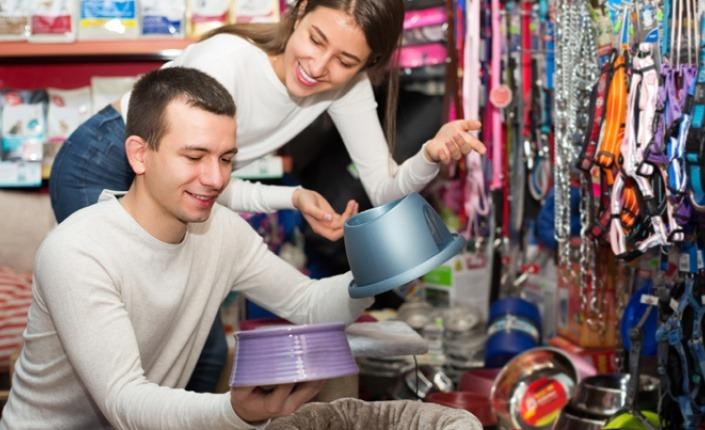10 Essentials You Need For Your New Pet

So you’ve brought a new puppy or kitten home. Now what? No need to fret. We’ve got the basics covered for you – what to buy and why you need it. Whether you’re a first-time pet owner or it’s been a while since you heard the sound of tiny paws around the house, we hope this checklist makes the transition to pet parenthood a smooth one.
You can even print this list out and take it with you the next time you stop by the pet store or keep this page open while you shop online.
- Collar with ID tags – Attach an identification tag with your contact information to the collar and fasten it around their neck. Remember that you want it to fit snugly, but not too tight. To check the fit, slide two fingers under the collar. If you can do that easily (without the collar falling off), you’ve found the perfect fit!
- Leash – Can you believe there was a time when your dog didn’t get excited at the sight of their leash? Your new pup will need to get used to the idea of wearing a leash before they put one on for the first time. Did you know cats can be trained to walk on a leash too? It’s true! Once your pet’s immunizations are up to date, you can take them out for a stroll through the neighbourhood.
- Crates and Carriers – When it comes to size, your pet’s new digs should be the right fit – not too big that they’ll have an accident and not too small that they can’t stretch out comfortably. Don’t forget to include a warm blanket, towel, or pillow for comfort. A favourite toy can also help ease any crate or carrier anxiety.
- Baby Gates – Once your new friend is allowed to have a bit more freedom around the house, you’ll want to make sure they stay put in an enclosed area. You’d be surprised how much trouble a tiny puppy or kitten can get into! You can use baby gates to block off entrances to rooms that are off-limits or unsafe.
- Toys, Toys, Toys – Puppies and kittens will chew anything in their path (and we mean anything). The best way to protect your stuff is to give them plenty of enticing toys and treats. Did your last pet love stuffed toys? What worked for one pet may not work for another. Have a variety of options on hand to figure out what your new friend will like best. They’ll also come in handy during the dreaded teething phase that puppy owners are all too familiar with.
- Bowls – All that house exploring can work up an appetite! Have stainless steel bowls, that are easy to clean and chemical free, ready for food and water. Keep an eye on the water bowl and make sure it is filled regularly.
- Potty Training Pads – Accidents happen. Minimize the mess in your house with these pads for pups. They’re also a good option for pet owners that live in apartments and can’t get outdoors fast enough to potty train.
- Litter Box – Closed or open? Clay or sand? Get to know your kitten’s preferences early on and choose a litter box style accordingly. Be prepared to scoop at least once or twice a day. A bad smell can deter a cat from using their litter box altogether.
- Cleaning Supplies – Remember when we said accidents happen? You’ll definitely want to have an arsenal of cleaning supplies at the ready while potty and litter box training. Look for pet-safe enzyme cleaners that will eliminate odours. Dogs are notorious for returning to the scene of the crime if they can still smell where they last had an accident.
- Food & Treats – Both kittens and puppies need food that is suited for their developmental and life stage. A nutritious diet at this early age will set them up for a healthier future. Of course, that doesn’t mean they can’t treat themselves every now and then. Treats will be your secret weapons when training your pet or distracting them during a stressful situation (for example, a vet appointment).
We hope this list has taken some of the guesswork out of shopping for your puppy or kitten. Now you can spend less time worrying and more time making memories with your new family member. Happy shopping!